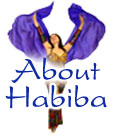- »Classes
- »Workshops/
Special Events - »Calendar
- »Gallery
- »Links
- »About Belly Dance
- »The Habiba Dance Ensemble website .








Habiba
The Studio
Habiba Dance Ensemble
.
.
.
.
.
.
.
.
.
.
.
.
.
Articles
Habiba has placed many of her collected writings online for the benefit of belly dancers and scholars. All articles are for personal use only. For mass distribution, reprints, or to publish these or future articles, please contact Habiba.
Ghawazi Articles
"The Ghawazi: Back From the Brink of Extinction (For now)" Gilded Serpent, posted July,2009
In January 2009, I went to Egypt with the aim of visiting Khairiyya Mazin, the last remaining practictioner of authentic Ghawazi dance. It had been on my mind for six years since I met her in Cairo at the 2003 Ahlan Wa Sahlan Festival. At that time things looked dire for Khairiyya and the legacy of the Ghawazi.
Link to Article
"The Legacy of the Ghawazi" Habibi, v. 20, no. 4, Fall 2005, p. 38-46
An overview of the origins and history of the ghawazi up to the present, including the American dancers that first discovered and studied with the Ghawazi. The evolution fo the ghawazi costume over 100's of years.

"Ghawazi revisited: a party in Luxor" Habibi, v. 21, no. 1, Winter 2005, p. 40-47
Habiba recounts her experiences with the Banat Maazin Ghawazi in Luxor in 1985 and 1989. An in-depth description of a typical Ghawzi performance. The current plight of the Ghawazi tradition, in danger of extinction.

Habiba...A Self Portrait
Habiba: A Self-portrait,Crescent Moon, Sept-Oct, 1997, p. 5-6.
The people and places that inspired Habiba to follow her path.

To open these files, you will need Adobe Reader software.

Template design by Six Shooter Media.
This website and all photographs within, are
©2010 Barbara Siegel, and may not
be used without her permission.
Website maintained by Fatima Bassmah








Habiba
The Studio
Habiba Dance Ensemble
.
.
.
.
.
.
.
.
.
.
.
.
.
Articles
Habiba has placed many of her collected writings online for the benefit of belly dancers and scholars. All articles are for personal use only.For mass distribution, reprints, or to publish these or future articles, please contact Habiba.
| Ghawazi Articles | |
| "The Ghawazi: Back From the Brink of Extinction (For now)" Gilded Serpent, posted July,2009
In January 2009, I went to Egypt with the aim of visiting Khairiyya Mazin, the last remaining practictioner of authentic Ghawazi dance. It had been on my mind for six years since I met her in Cairo at the 2003 Ahlan Wa Sahlan Festival. At that time things looked dire for Khairiyya and the legacy of the Ghawazi. |
Link to Article |
| "The Legacy of the Ghawazi" Habibi, v. 20, no. 4, Fall 2005, p. 38-46
An overview of the origins and history of the ghawazi up to the present, including the American dancers that first discovered and studied with the Ghawazi. The evolution fo the ghawazi costume over 100's of years. |
|
| "Ghawazi revisited: a party in Luxor" Habibi, v. 21, no. 1, Winter 2005, p. 40-47
Habiba recounts her experiences with the Banat Maazin Ghawazi in Luxor in 1985 and 1989. An in-depth description of a typical Ghawzi performance. The current plight of the Ghawazi tradition, in danger of extinction. |
|
| Habiba...A Self Portrait | |
| Habiba: A Self-portrait,Crescent Moon, Sept-Oct, 1997, p. 5-6. The people and places that inspired Habiba to follow her path. | |
Template design by Six Shooter Media.
This website and all photographs within, are
©2010 Barbara Siegel, and may not
be used without her permission.
Website maintained by Fatima Bassmah
